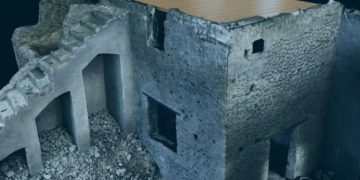NASA’S Perseverance Rover has found an intriguing black-and-white striped rock that the space agency says is “unlike any seen on Mars before”.
The stone, dubbed ‘Freya Castle’ or “zebra rock”, was found in the Jezero Crater, where scientists believe they have the best chance of finding remnants of ancient alien life.

Perseverance found the rock on a flat sandy plane above the deep sloping sides of the 1,000metre-deep crater last month[/caption]

The science team believes the 20cm rock is “unlike any seen in Jezero Crater before, and perhaps all of Mars”[/caption]

The Perseverance rover has which has been roaming Mars since July 2020[/caption]

The loose stone is also unlikely to have originated from the area in which it was found, with experts suggesting it could have rolled downhill from a source higher up[/caption]
The Jezero Crater is thought to be what’s left of an ancient lake.
Perseverance, which has been roaming Mars since July 2020, found the rock on a flat sandy plane above the deep sloping sides of the 1,000metre-deep crater last month.
“While driving across unremarkable pebbly terrain, beady-eyed team members spotted a cobble in the distance with hints of an unusual texture in low resolution Navcam images, and gave it the name ‘Freya Castle’,” Nasa wrote in a statement.
The team planned a multispectral observation, a picture that shows beyond what the human eye can see, including infrared and ultraviolet light, using the Mastcam-Z camera.
“When these data were downlinked a couple days later, after Perseverance had already left the area, it became clear just how unusual it was,” Nasa added.
“The internet immediately lit up with speculation about what this “zebra rock” might be, and we’ve enjoyed reading your theories!”
The science team believes the 20cm rock is “unlike any seen in Jezero Crater before, and perhaps all of Mars”.
The loose stone is also unlikely to have originated from the area in which it was found, with experts suggesting it could have rolled downhill from a source higher up.
While it appears visibly different from underlying bedrock, Nasa’s knowledge of its chemical composition – what the rock is made up of – is limited.
Although early interpretations suggest the rubble is an igneous or metamorphic rock.
It’s possible that a combination of igneous and metamorphic processes could have created its stripes.
Igneous rocks form when hot, molten rock crystallises and solidifies.
Meanwhile, metamorphic rocks start out as some other type of rock, but change significantly as a result of external factors like heat, pressure or mineral-rich surroundings.
“This possibility has us excited, and we hope that as we continue to drive uphill, Perseverance will encounter an outcrop of this new rock type so that more detailed measurements can be acquired,” the team concluded.
“Could these be our first glimpses at ancient rocks uplifted from depth by the Jezero impact, now exposed on the crater rim? Only time will tell…”
How long does it take to get to Mars?
It's not that short of a trip…
- There’s an immense distance between Earth and Mars, which means any trip to the red planet will take a very long time
- It’s also made more complicated by the fact that the distance is constantly changing as the two planets rotate around the sun
- The closest that the Earth and Mars would ever be is a distance of 33.9million miles – that’s 9,800 times the distance between London and New York
- That’s really rare though: the more useful distance is the average, which is 140million miles
- Scientists on Earth have already launched a whole bunch of spacecraft to (or near) Mars, so we have a rough idea of how long it takes with current technology
- Historically, the trip has taken anywhere from 128 to 333 days – admittedly a huge length of time for humans to be on board a cramped spacecraft.




























